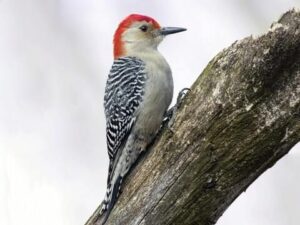
“Rat-A-Tat-Tat” is a common backyard noise for us. That’s because we have lots of mature trees, which attract woodpeckers. Occasionally, we’ll have a pair of Pileated woodpeckers fly through, but more common are our Red-bellied woodpeckers. Their rate of pecks per minute is over 100, thus the “Rat-A-Tat-Tat”.
Red-bellied Woodpeckers are pale, medium-sized woodpeckers common in forests of the East. Their strikingly barred backs and gleaming red caps make them an unforgettable sight. Many call them Red-headed woodpeckers (another species.) Though they do have red patches on their heads, they are indeed Red-bellied Woodpeckers.
According to the Audubon Society, Red-bellied Woodpeckers bring bright colors and entertaining action to bird feeders. They are attracted to feeders filled with suet (in winter), peanuts, and sometimes sunflower seeds. They’ve even been spotted drinking nectar from hummingbird feeders. Dead trees may encourage the birds to forage naturally or even nest in your yard.
A Red-bellied Woodpecker can stick out its tongue nearly 2 inches past the end of its beak. The tip is barbed, and the bird’s spit is sticky, making it easier to snatch prey from deep crevices. Males have longer, wider-tipped tongues than females, possibly allowing a breeding pair to forage in slightly different places on their territory and maximize their use of available food.
You may sometimes see Red-bellied woodpeckers wedge large nuts into bark crevices, then whack them into manageable pieces using their beaks. They also use cracks in trees and fence posts to store food for later in the year, a habit it shares with other woodpeckers in its genus.
For birds that nest in cavities, nest holes are precious turf. Red-bellied Woodpeckers have been known to take over the nests of other birds, but more often they’re victims to the aggressive European Starling. As many as half of all Red-bellied Woodpecker nests in some areas get invaded by starlings.
You may occasionally see a Red-bellied Woodpecker flying quickly and erratically through the forest, abruptly changing direction, alighting for an instant and immediately taking off again, keeping up a quick chatter of calls. Scientists categorize this odd behavior as a type of play that probably helps young birds practice the evasive action they may one day need.
As long as these lovely birds do their Rat-A-Tat-Tats on the trees and not on the side of my house, they are welcomed guests.

